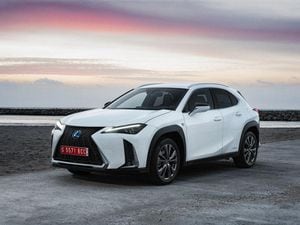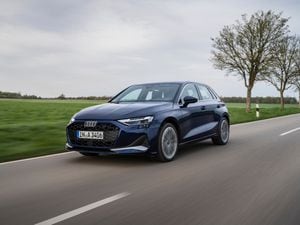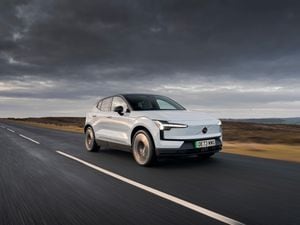First drive: Hybrid powertrain gives the Lexus UX an edge against compact SUV rivals
Is the Lexus UX the new compact SUV to buy? Jack Evans heads to Barcelona to find out

What is it?

The rise of the compact SUV is seemingly unstoppable and now Lexus wants in on the action. It’s why it has introduced this – the UX. Slotting underneath the NX and RX models in the firm’s range of SUVs, the NX sits on a new compact platform and, as with all other current Lexus cars, it’s a hybrid. Its powertrain means that it does offer something different (there are few other petrol-electric hybrid compact SUVs on the market), and it does this while delivering Lexus’s well-known high standard of quality.
What’s new?

It’s the first Lexus to use the Global Architecture – Compact (GA-C) platform, giving it better balance while retaining the car’s compact dimensions. There’s a distinctive exterior design too, while Lexus’s latest cabin technology has been used inside. The UX is being pitched at young families who want a car with the space of an SUV but the dinky proportions of a hatchback as well.
The UX is also being offered in either front- or all-wheel drive, giving buyers a little more choice when it comes to the car’s driven wheels. There is, however, just one engine available.
What’s under the bonnet?

All UX models use the same engine for propulsion. It’s a 2.0-litre petrol unit, linked to two electric motors across the front axle in front-wheel-drive versions like our test car, while all-wheel-drive E-Four versions have the engine paired with an additional electric motor at the rear axle, driving the back wheels. Together, they produce 181bhp, endowing the UX (with front-wheel drive) a 0-60mph time of 8.4 seconds and a 110mph top speed. Acceleration figures for the all-wheel-drive version are slightly worse, although the top speed remains the same.
Lexus claims the UX will return up to 53.3mpg combined and emit 97g/km of CO2. This is a self-charging powertrain too – there’s no option to plug it in, with the batteries’ energy being replaced either by the combustion engine or through regenerative braking.
What’s it like to drive?

The way the UX drives is one of its most surprising aspects. Yes, there’s some drone generated by the engine under hard acceleration (thank the CVT gearbox for this), but there’s very little body roll in the corners, and there’s plenty of weight to the steering too. It gives you a lot of confidence when placing the car. Push too hard, however, and it will be prompted into understeer – it’s not difficult to overcome the front tyres.
Our F-Sport specification car rode on larger 18-inch wheels and tyres, and these did contribute to a fair amount of road noise at speed. That said, it’s contrasted by a quiet around-town experience, with the electric motor making for swift and silent progress. It’s not a quick car, but it doesn’t feel underpowered – the 181 horses available give the UX enough grunt for merging on to motorways or overtaking relatively easily.
How does it look?
The UX’s dinky proportions mean it has quite a small imprint on the road. However, its angular styling does help to give it a bit more presence than you may think – the front and rear styling is especially strong.
However, the rear-three-quarter angle appears too fussy in our opinion, while there looks to be too much gap left between the back wheels and the arches – and this isn’t helped by the squared-off design of the arches themselves. That said, it does stand out against other small SUVs – and remember, this is a heavily congested market, so standing out is no bad thing.
What’s it like inside?

The UX delivers what we’ve come to expect from Lexus interiors. That is, an elegantly designed and well-finished cabin let down a touch by strange ergonomics. The central column is festooned with buttons, and the same can be said for the steering wheel. We still have a gripe with the touchpad controller for the infotainment too; it just isn’t as intuitive as rival systems and is distracting to use.
That said, it does well in the practicality stakes. There’s a reasonable level of legroom in the back for a car in this class, although the 320 litres of seats-up boot space feel a little mean for this type of car – and it’s even smaller in all-wheel-drive versions.
What’s the spec like?

Our car came in F-Sport specification, which sits in the middle of three trim levels. It has a decent standard of kit too, including Lexus’s full range of safety assistance systems, as well as features such as dual-zone climate control and parking sensors at the front and rear of the car.
The standard-fit infotainment system is a seven-inch unit, although our test car came with the upgraded 10.3-inch version. It’s great to look at and lifts the feel of the cabin, but isn’t as easy to get along with as systems in rival cars. The satellite navigation isn’t as sharp, and the overall user-friendliness isn’t quite up to scratch.
F-Sport cars get a full exterior styling package too, so opt for this one if you’re looking for the most premium-looking version available.
Verdict

Although the compact SUV segment is a crowded one, Lexus has done well to offer something different with the UX. There for people who don’t want to have to plug in their hybrid, it’s able to deliver the electrified driving experience with fewer drawbacks. Yes, it does mean that hard acceleration isn’t the most pleasant of experiences, but those who spend most of their time at lower speeds around town will no doubt find the UX suits them down to the ground.





